I'm making a simple chat application using TcpClient and TcpServer from System.Net.
I got everything working on my PC, the server communicates with the client and vice versa. But when I try to connect to the same server application using another PC (even on the same subnet as my PC) the thing doesn't work.
I've tried port-forwarding through my router, firewall and still nothing.
The Can you see me website says that the connection is being refused. Although!! Sometimes it says that the connection is timed out completely.
I am not sure what's wrong with my code or my PC, I would really appreciate some help from people that are more experienced in this area than I am.
Here is the configuration for the port forwarding in my router:

If you need the code for the client and the server, here they are:
P.S. I make the change to the client in the BeginConnect() part at the bottom in order to change the IP address that I'm connecting to
Client:
using System;
using System.Text;
using System.Windows.Forms;
using System.Net.Sockets;
using System.Net;
namespace TcpTest_Client_
{
public partial class Form1 : Form
{
TcpClient client;
IPAddress localIP = null;
bool connected = false;
public Form1()
{
InitializeComponent();
}
public void clientConnectCallback(IAsyncResult result)
{
try
{
client.EndConnect(result);
Log("Connected to " + client.Client.RemoteEndPoint);
connected = true;
NetworkStream clientStream = client.GetStream();
byte[] message = new byte[4096];
int bytesRead;
while (true)
{
bytesRead = 0;
try
{
//blocks until a client sends a message
bytesRead = clientStream.Read(message, 0, 4096);
}
catch (Exception ex)
{
//a socket error has occured
Log(ex.Message);
break;
}
if (bytesRead == 0)
{
//the client has disconnected from the server
Log("Server on has disconnected");
break;
}
//message has successfully been received
UTF8Encoding encoder = new UTF8Encoding();
string bufferincmessage = encoder.GetString(message, 0, bytesRead);
Log("Server: " + bufferincmessage);
}
}
catch (Exception ex)
{
Log(ex.Message);
}
}
public void Log(string msg)
{
richTextBox1.BeginInvoke(new Action(
() =>
{
richTextBox1.Text += msg + "\n";
}));
}
private void Form1_Load(object sender, EventArgs e)
{
foreach (IPAddress addr in Dns.GetHostAddresses(Dns.GetHostName()))
{
if (addr.AddressFamily == AddressFamily.InterNetwork)
{
localIP = addr;
break;
}
}
client = new TcpClient(AddressFamily.InterNetwork);
}
private void button2_Click(object sender, EventArgs e)
{
try
{
client.BeginConnect(IPAddress.Parse("109.252.107.144"), 1234, clientConnectCallback, client);
}
catch (Exception ex)
{
Log(ex.Message);
}
}
private void button1_Click(object sender, EventArgs e)
{
if (connected)
{
UTF8Encoding encoder = new UTF8Encoding();
NetworkStream clientStream = client.GetStream();
byte[] stringToSend = new byte[richTextBox2.Text.Length];
stringToSend = encoder.GetBytes(richTextBox2.Text);
clientStream.Write(stringToSend, 0, stringToSend.Length);
}
}
}
}
Server:
using System;
using System.Collections.Generic;
using System.Text;
using System.Windows.Forms;
using System.Net;
using System.Net.Sockets;
using System.Threading;
namespace TcpTest
{
public partial class Form1 : Form
{
private TcpListener server;
private List<Thread> clientThreads = null;
public Thread MainThread;
public Form1()
{
InitializeComponent();
}
public void Log(string msg)
{
richTextBox1.BeginInvoke(new Action(
() =>
{
richTextBox1.Text += msg + "\n";
}));
}
public static string bufferincmessage;
public void AcceptSocketPackets(object client)
{
TcpClient tcpClient = (TcpClient)client;
NetworkStream clientStream = tcpClient.GetStream();
byte[] message = new byte[4096];
int bytesRead;
while (true)
{
bytesRead = 0;
try
{
//blocks until a client sends a message
bytesRead = clientStream.Read(message, 0, 4096);
}
catch (Exception ex)
{
//a socket error has occured
Log(ex.Message);
break;
}
if (bytesRead == 0)
{
//the client has disconnected from the server
Log("Client on " + tcpClient.Client.RemoteEndPoint + " has disconnected from the server");
break;
}
//message has successfully been received
UTF8Encoding encoder = new UTF8Encoding();
bufferincmessage = encoder.GetString(message, 0, bytesRead);
Log("Client from " + tcpClient.Client.RemoteEndPoint + ": " + bufferincmessage);
string stringToSend = "You sent me: " + bufferincmessage;
byte[] messageToSend = new byte[stringToSend.Length];
messageToSend = encoder.GetBytes(stringToSend);
clientStream.Write(messageToSend, 0, messageToSend.Length);
}
}
public void SocketAcceptCallback(IAsyncResult result)
{
TcpClient newClient = server.EndAcceptTcpClient(result);
Log("Accepted client on " + newClient.Client.RemoteEndPoint);
clientThreads.Add(new Thread(new ParameterizedThreadStart(AcceptSocketPackets)));
clientThreads[clientThreads.Count - 1].Start(newClient);
server.BeginAcceptTcpClient(SocketAcceptCallback, server);
}
private void Form1_Load(object sender, EventArgs e)
{
MainThread = Thread.CurrentThread;
clientThreads = new List<Thread>();
try
{
IPAddress localIP = null;
foreach (IPAddress addr in Dns.GetHostAddresses(Dns.GetHostName()))
{
if (addr.AddressFamily == AddressFamily.InterNetwork)
{
localIP = addr;
break;
}
}
localIP = IPAddress.Any;
// could also use this:
// server = new TcpListener(new IPEndPoint(IPAddress.Any, 1234));
server = new TcpListener(new IPEndPoint(localIP, 1234));
Log("Starting server on " + localIP + ":1234");
server.Start(6);
server.BeginAcceptTcpClient(SocketAcceptCallback, server);
Log("Started server on " + localIP + ":1234");
}
catch (Exception ex)
{
Log(ex.Message);
}
}
}
}